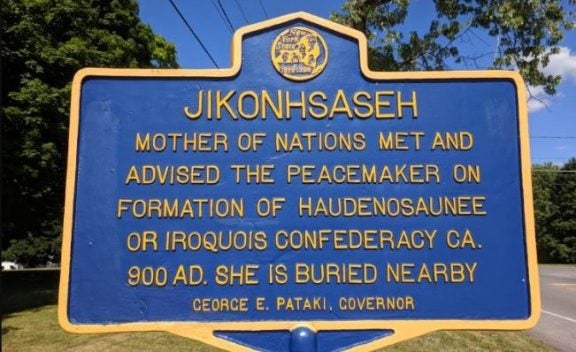Judy Moore: Let’s talk about Jigonhsasee, the Mother of Nations
Published 12:00 pm Thursday, September 1, 2022
|
Getting your Trinity Audio player ready...
|
Romans 12:18 of the King James Bible says “If it be possible, as much as lieth in you, live peacefully with all men”. That could describe Jigonhsasee. Alternatively spelled Jikonhsaseh and Jikonsase, she was a member of the Iroquois or Haudenosaunee nation who was known for her hospitality to warriors who traveled to and from battles. Many would stop at her longhouse for a meal and rest. Although she loved to hear their war stories, Jigonhsasee created an atmosphere of peace among Native American nations, no matter the tribe; there were no enemies in her longhouse.
Consequently, two men, Deganawida, The Great Peacemaker and Hiawatha of the Onondaga tribe, had put down the desire to war seeking a peaceful existence. One day they stopped at Jigonhsasee’s home wishing to spread that message among the various tribes, which intrigued her. Moreover, she inquired about how this could be done and The Great Peacemaker told her that a meeting of the nations under one longhouse would be the way.
The women of the Iroquois nation are matrilineal in that they are involved in their government choosing the chiefs of the councils. Jigonhsasee was tasked with contacting the various Clan Mothers to secure an audience with the leaders of the five nations: the Seneca, Mohawk, Cayuga, Oneida and Onondaga. Around 1570-1600, this meeting for peace took place and Jigonhsasee became known as “The Mother of Nations”.
In the beginning four of the nations consented to join the new Haudenosaunee Confederacy except the Onondaga who were ruled by a bloodthirsty chief named Tadadaho. Legend has it that he was so evil his hair grew into snakes. The Great Peacemaker and Hiawatha implored him to join, yet, he would not relent. Subsequently, the hospitable and peaceful Jigonhsasee confronted him to strike her, commenting how she knew about his treatment of women and how she is any different from the others.
In his shame, Tadadaho allowed her to comb the snakes out of his hair. In another legend, she sang him a sacred healing song which drove evil from his mind. Either way he finally agreed to join and the Iroquois Confederacy was complete. The Onondaga became the firekeepers of the Confederacy making it one of the oldest representative governments in the world.
The Great Law of Peace as well as other laws were written into sacred wampum belts; among these was the Women’s Nomination Belt. Jognhsasee made it clear that the law of peace wouldn’t have been possible without the women having an equal stake in the new government. The Clan Mothers of the Iroquois could withhold food if they didn’t agree with the causes of war the chiefs wanted to fight. The Haudenosaunee government has maintained its balance of power and is very active today.
Jigonhsasee chose a path of peace to craft a sustainable government that was beneficial to all in the Iroquois Confederacy. The five nations came together in a peaceful way to solve their problems. The Clan Mothers of the Iroquois Confederacy with their strong position in government were a blueprint which blazed the trail and broke the glass ceiling for women’s suffrage.
Judy Moore is a tour guide at The Central High Museum living in Wylliesburg. She can be reached at v5agabond2@gmail.com.




